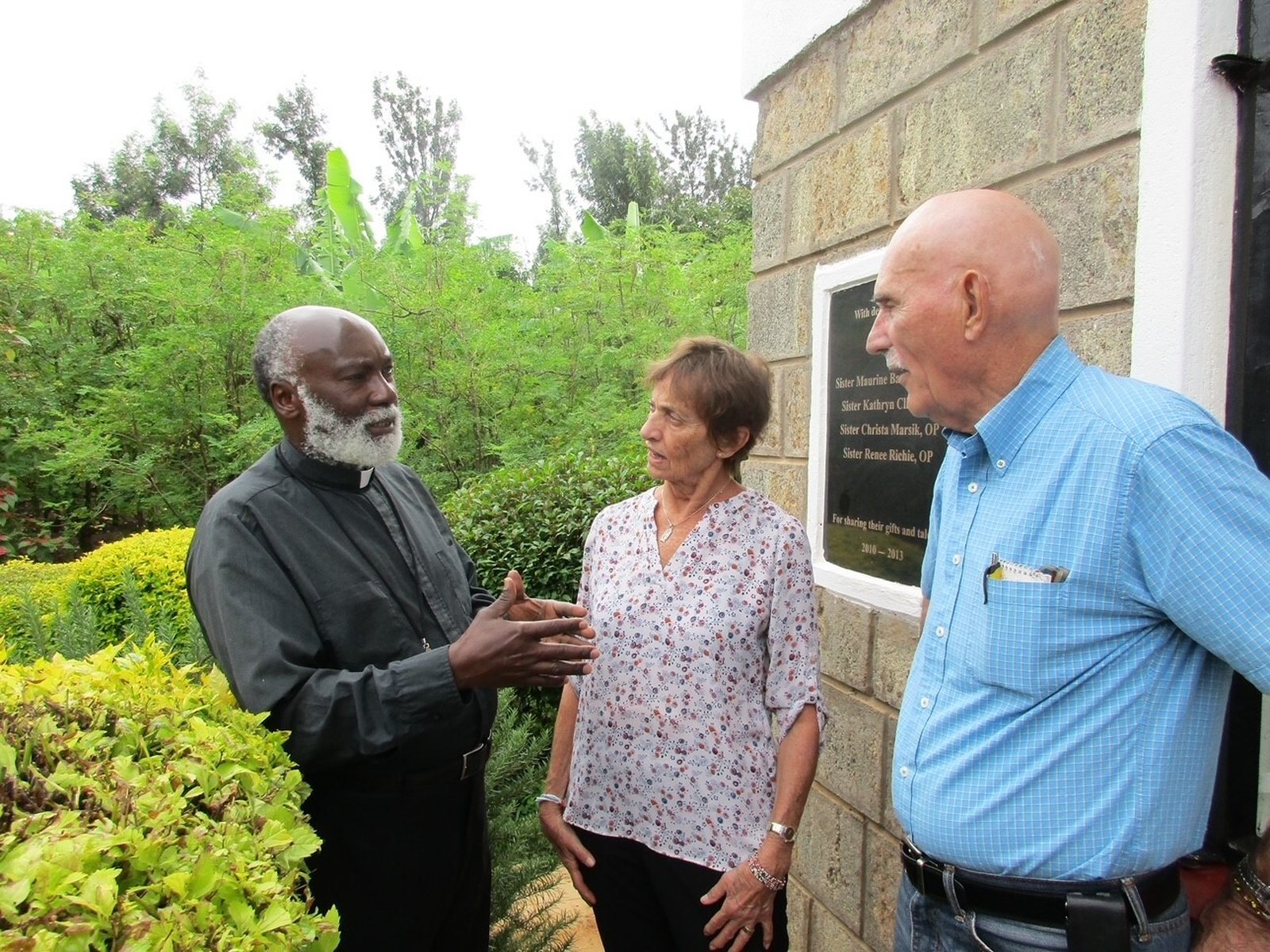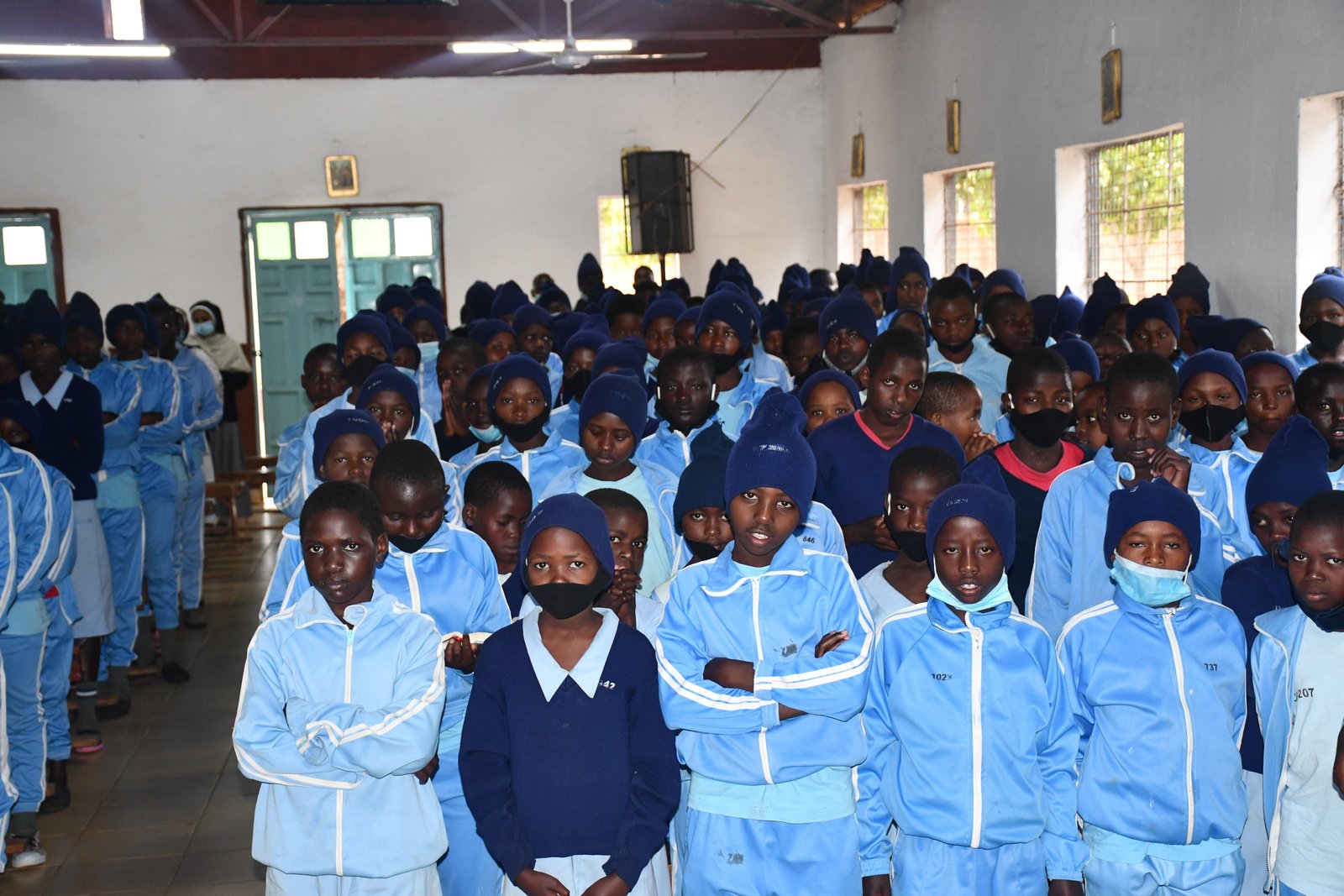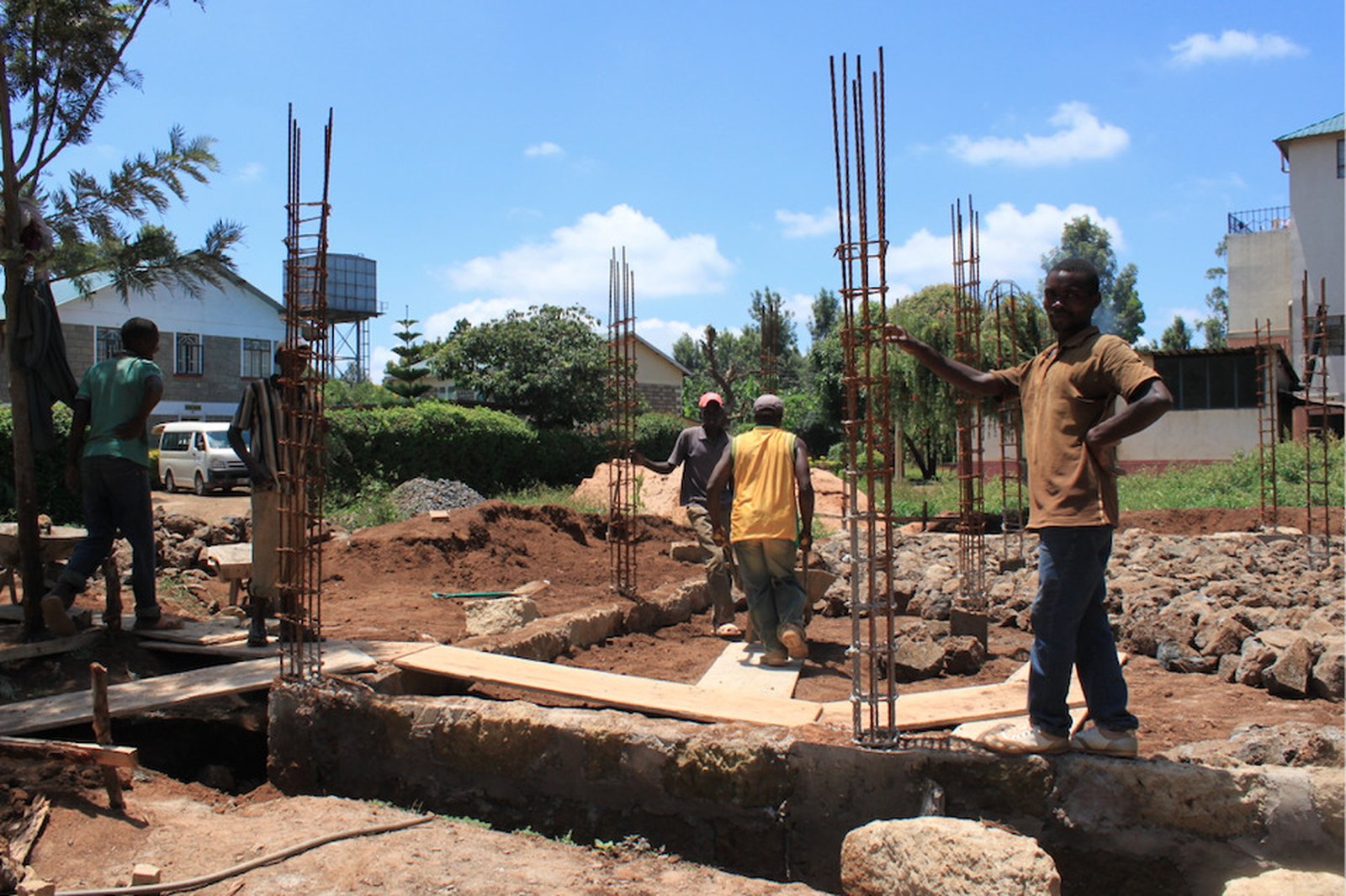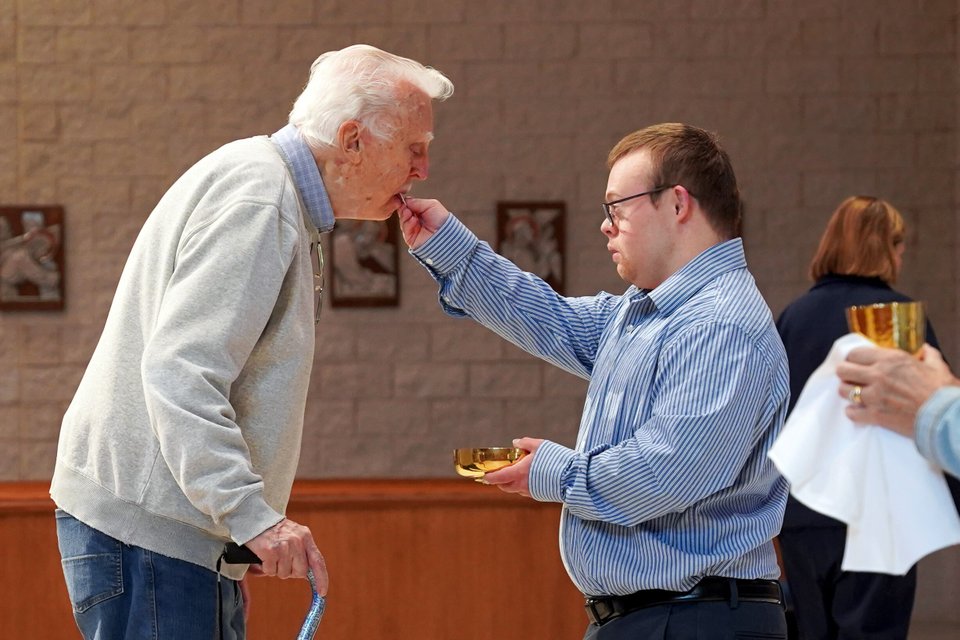Bud and Sue Ozar of St. Ambrose Parish raise awareness, funds to help pioneering priest minister to destitute kids, build a spiritual home
MERU, Kenya — Fr. Francis Riwa has been spending the better part of the last two years building St. Rita Church at his Children’s Village complex in Meru, Kenya.
But for more than 20 years, Fr. Riwa has been building another church — the domestic church — by serving the poor and destitute orphans of northern Kenya, giving them shelter, food, clothing, an education and a future.
As executive director of Children’s Village, Fr. Riwa oversees the 300 girls of the St. Clare girls campus, the 450 boys at the St. Francis boys campus, and 220 at the St. Florian campus for children born with HIV.
Fr. Riwa set about his mission in 1999, when he was ministering to the street children of Meru, caring for orphan girls who are sold as dowries in marriages, boys who were from illegitimate pregnancies and orphans infected with HIV who have been abandoned by the reserved, male-dominated culture of northern Kenya.

The success of Children’s Village has been documented by Catholic news outlets around the world, but now he has a new task: building a church to serve the expanding community.
“The idea of building the church was not in my mind; it wasn’t my priority, because when I look at the church, I don’t see a building, I see a people,” Fr. Riwa told Detroit Catholic. “I want to build these children, build this community.”
Still, serving Children’s Village meant cramming into the very small St. Rita Church on the campus grounds — not an ideal situation in the era of COVID-19. So, with a bit of pressure from Fr. Riwa’s bishop, he and the Children’s Village community began a fundraiser to finish the church project that is nearly 50 percent complete, Fr. Riwa said.
Creating opportunities for children
Fr. Riwa was born March 13, 1956, in Tanzania. He came to Kenya in 1973 to study for the priesthood, being ordained for the Diocese of Meru, Kenya, in 1987. Serving in the pastoral community in northern Kenya for 11 years, Fr. Francis Riwa came across the plight of the street children living in Meru, knowing he had to do something.
So taking a cue from his namesake, St. Francis, Fr. Riwa went about building a church: a spiritual church, where the poor and forgotten children of Kenya were the spiritual stones.

“I help these children, preparing them for a bright future, using the power of mind and the spiritual life to build them,” Fr. Riwa said. “This school is built on a life of prayer, study, faith and work. We have a girls school from kindergarten to high school, and they later go to different colleges and universities.
“For the boys, the school runs from kindergarten and up to high school and later, as we assist them to go to different colleges,” Fr. Riwa explained. “My part is the spiritual part. I’ve had so many challenges all these years. We’re helping these children come together and give them a direction.”
Roughly a third of Kenya lives below the poverty line — $1.90 per day in U.S. currency — with nearly one out of five children having stunted growth because malnutrition and dealing with the ongoing AIDS/HIV endemic in the country.
Children born with HIV/AIDS are seen as social outcasts in northern Kenya, a mostly rural region where it’s common for poorer families to sell their daughters as wives in order to claim a dowry.
How a Grosse Pointe couple got involved
Seven years into his effort, Fr. Riwa’s project got support from an unexpected place: Grosse Pointe, Michigan.
It was 2006 when Bud and Sue Ozar, two empty-nesters and parishioners of St. Ambrose Parish in Grosse Pointe Park, were in Kenya, looking to help after receiving missionary training in California and serving a tour in American Samoa.

“When our last son finished college, we were called to go work in the developing world,” Sue Ozar said. “We left our jobs — weren’t ready to retire from an income point of view — but we left our jobs and went to the Samoa islands and eventually came to Kenya.”
Upon meeting Fr. Riwa, this white-bearded priest working with children who lived in some of the most miserable conditions the Ozars had ever seen, the couple went to work. Bud became an administrator with the bishop of the diocese, and Sue was a teacher and counselor for the children living on the street.
“We were there when Father branched out to the HIV children,” Bud Ozar said. “When their parents die because they have the virus, you have these toddlers walking around a village, and people are afraid of this child carrying this dreadful disease. So no one takes care of this child; they live on the street, and the child just dies, usually by age 7.”
The Ozars immersed themselves in the situation, doing what they could to teach, and learn from, the children in Fr. Riwa’s Children’s Village in Meru.
The more the couple learned of the challenges, the more they knew they were needed.
“I remember this young woman at St. Clare, she would get very ill every time she went back to her village, and we couldn’t figure out why,” Sue Ozar said. “It was discovered the girl had many venereal diseases, because she had been married. She was a 12-year-old girl, married off to an elder man. Fr. Riwa didn’t let that continue. He took it upon himself to find a way to buy back this child, because the man had already paid a dowry for her. I remember teaching this girl; she is so bright, so full of hope, but she was ruined by this elder man.

“The last time we were in Kenya, I spent many hours talking with her, and she’s so grateful to Fr. Riwa because he organized to buy her back, to go back to her village, to have her life back,” Sue Ozar said.
“There have been so many adventures,” Fr. Riwa added. “With our culture, now with COVID-19, some schools had to close. The children have been at home, and that leaves the girls more open to abuse. So St. Clare is there to rescue these girls. We have one of the most successful programs in East Africa, not just Kenya.”
Establishing a successful, lifelong center of learning has been transformative for northern Kenya, with alumni going on to university to get teaching certificates to returning to Children’s Village to teach the next generation.
In a county of needs, why is a church necessary?
While a school and medical center are key, the faith component — the need for prayer and a proper church — cannot be overstated.
“They have such little recreation time, but when they do, they will dart into what is now the present chapel,” Bud Ozar said. “They will dart in there and pray for their sponsors in America who have saved them. They know they wouldn’t be alive if American people did not donate, and I was impressed. I grew up in the Church and never did that, even though I was in parochial school and the church was right there. But for them, when they have time to themselves, they're praying — 300 children, not a single adult — and they are all singing hymns and praying together.”

Backed by American donors — due in part to Fr. Riwa’s visit to Metro Detroit to visit the Ozars' home and meet members in the community — Fr. Riwa has hired local labor and contractors, many saying they would volunteer for the project, cutting down on the cost of the project. Building began in April 2021.
“We have the basic foundations down, but now is the second part, which is more delicate and is going to cost $50,000," Fr. Riwa said. "The good thing is, even though it’s costly, we are using local contributions for materials, so it is going to cost less than it should.”
In a country mired in poverty, with children seen barefoot and abandoned, building a church may seem superficial. Couldn’t the money go to something useful?
In fact, nothing could be more necessary, Sue Ozar said.
“These girls, young women and children, they pray all day long,” Sue Ozar said. “They wake us up in the morning, because they are already at church, praying and singing. They pray in the morning, the afternoon, the evening, they pray at night. They pray as much as any community of religious women do. So this church means everything to them. Their faith is what got them there, saving them from all the abuse and being left out on the street. Our concept of a church is something much different (than) for these young women growing up in this country.”

The Ozars are back in Michigan, but are still supporting Children’s Village.
“What an incredible success all of this has been,” Bud Ozar said. “It’s very unusual for young women to even get into high school, and they are shattering the glass ceiling. They are becoming professionals, standing toe-to-toe with men in that culture. (These are) young women who would not be alive if Fr. Riwa did not reach out and accept them.
“I remember seeing a little girl dressed in rags you wouldn’t even wash your garage floor with,” Bud Ozar continued. “But then two or three days later, she has a St. Clare uniform on, her arm around her new best friend. And suddenly, this frightened little girl was a joyful little girl who rediscovered her childhood. The child who was lost was suddenly alive. You see that, and you know that here at St. Rita’s, with this church, with this school, miracles happen here.”
Donors can visit Children Village's GoFundMe page to help raise money for the construction of St. Rita Church
Copy Permalink
Missions Personal witness












